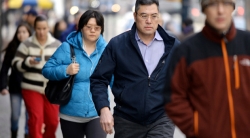
With a death of a pedestrian the seemingly relentless march forward of autonomous vehicles has taken a pause as reported by the New York Times. From a legislative standpoint autonomous vehicles (AVs) are operating in a piece meal legal environment, and the state of Arizona was an early adopter, inviting these vehicles to be tested on the state’s road network in a “regulation free zone. “Then on Sunday night, an autonomous car operated by Uber — and with an emergency backup driver behind the wheel — struck and killed a woman on a street in Tempe, Ariz. It was believed to be the first pedestrian death associated with self-driving technology. The company quickly suspended testing in Tempe as well as in Pittsburgh, San Francisco and Toronto. The accident was a reminder that self-driving technology is still in the experimental stage, and governments are still trying to figure out how to regulate it.”
The Uber car, a Volvo XC90 sport utility vehicle outfitted with the company’s sensing system, was in autonomous mode with a human safety driver at the wheel but carrying no passengers when it struck Elaine Herzberg, a 49-year-old woman, on Sunday around 10 p.m. Sgt. Ronald Elcock, a Tempe police spokesman, said during a news conference that a preliminary investigation showed that the vehicle was moving around 40 miles per hour when it struck Ms. Herzberg, who was walking with her bicycle on the street. He said it did not appear as though the car had slowed down before impact and that the Uber safety driver had shown no signs of impairment. The weather was clear and dry.
There has been early discussion on the computer based “ethics” of the autonomous vehicle, and the fact that the vehicle was being designed to save its occupants first. Autonomous vehicles have been hailed as way to stem the annual deaths of over 37,000 (2016 figures) people on the road by safer, logical control. But the technology is only a decade old, and “now starting to experience the unpredictable situations that drivers can face.”
“This tragic incident makes clear that autonomous vehicle technology has a long way to go before it is truly safe for the passengers, pedestrians, and drivers who share America’s roads,” said Senator Richard Blumenthal, Democrat of Connecticut. While autonomous vehicle testing has temporarily halted with this death, investigators are examining what led to this vehicle’s failure to recognize the pedestrian. Vehicle developers have expressed challenges in teaching the systems to adjust for unpredictable human behaviour. As a professor at Arizona State University expressed “We’ve imagined an event like this as a huge inflection point for the technology and the companies advocating for it,” he said. “They’re going to have to do a lot to prove that the technology is safe.”


